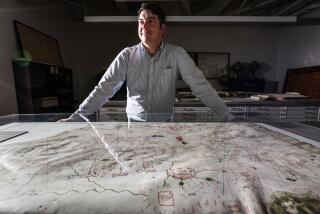The Magna Cartographers : MAPPING THE NEXT MILLENNIUM: The Discovery of New Geographies, <i> By Stephen S. Hall (Random House: $30 384 pp.)</i>
- Share via
Geography professors expecting to find a new admirer in science writer Stephen S. Hall will be surprised and probably none too pleased. In this survey of modern cartography, Hall finds counterparts to intrepid explorers such as Columbus and Magellan not in today’s financially embattled geography departments but among the scientists and mathematicians who are using computer graphics to represent and analyze the frontiers of knowledge.
Hall eloquently extols frontier explorers such as the anonymous engineers of Voyager 2, for example. Navigating with adhesive dots and grid paper, they successfully brought “a rickety robotic spacecraft” traveling at 61,000 miles per hour close enough to Neptune, orbiting the sun at 12,000 m.p.h., to observe both the planet and its moon Triton in superb detail. William Pecora and Virginia Norwood of Landsat and Bill Haxy of Seasat, in turn, used images from space-satellite observatory programs to revolutionize our knowledge of the land and the ocean floor, but only after a long struggle to lure government dollars away from military and space-shuttle programs.
The cartographers that Hall seems to admire most work even more in the dark than did Columbus and Magellan, for their job, essentially, is to map the invisible. We see how Harvard’s Adam Dziewonski derives his stunningly colorful images of the Earth’s core and mantle from seismic data, for instance, and how the University of Wisconsin’s John Kutzbach, by mapping 18,000 years of the Earth’s climate, has raised portentous questions about global warming.
Perhaps the most rarefied of researchers are the X-ray crystallographers, who spend years of painstaking cultivation, high-voltage photography and higher-order mathematics to fashion three-dimensional maps of molecules. They are represented here by the University of Pittsburgh’s John Rosenberg, whose work is helping us answer the life-or-death question of how proteins recognize the precise spot on a DNA chain to do their work.
Throughout “Mapping,” Hall sustains a string of vivid, concise, often witty metaphors that make him one of the best scientific explainers at work. Whether using a baseball field to introduce celestial mapping or comparing slices of frozen rat brain to ginger on a sushi plate (I think I’ll order tempura next time), he always has the telling phrase.
As an interpretive history of science, “Mapping” is less persuasive. While knowledgeable about seminal events in the histories of mapping and science, Hall still presents the late 20th Century as a miraculous, computer-driven renaissance akin to 16th-Century exploration and cartography. But today’s scientific graphics are no deus ex Macintosh . Far from a newly inspired quest, modern cartography is a direct outgrowth of the early modern period and of the 19th Century. There is no need to leap over such giants of the last century or two as the great Belgian statistician Lambert-Adolphe Quetelet and the French “chronophotographer” Etienne-Jules Marey.
Hall also seems concerned about keeping controversy out of his text. His chapter on human-gene mapping, for example, ends with a prediction from the University of Utah’s Mark Skolnick that human-genetic sequences will soon be tested at birth and that those associated with disease will be “countered . . . before there are symptoms or cell degradation.” While whole books have been written about the ethical hazards of genetic screening, there’s nary a mention of them in Hall’s chapter.
Finally, some older but still vital scientific geographies are now at risk that (as far as I can see) Hall does not address, such as the identification, range mapping and preservation of species as habitats vanish. E. O. Wilson of Harvard has pointed out that only 750,000 of a likely minimum of 10 million insect species have been identified and “the human genome is not going to disappear in the next 20 years.” Biogeography, too, is worth considering for the next millennium.






